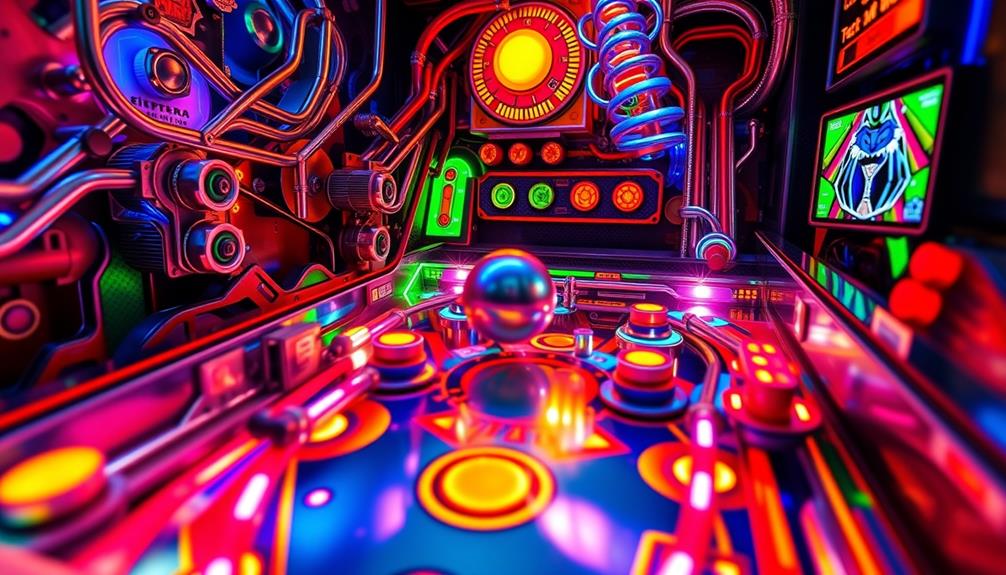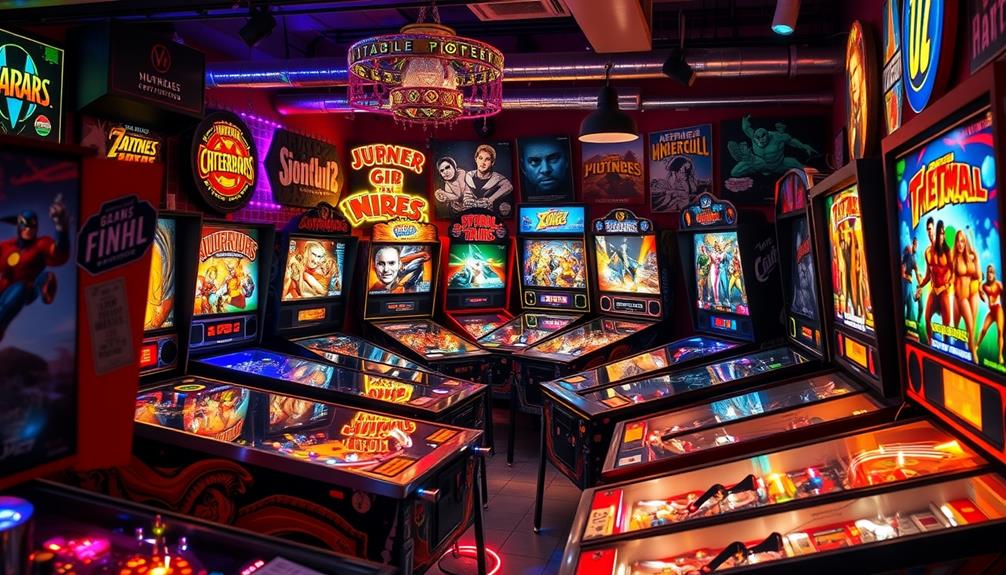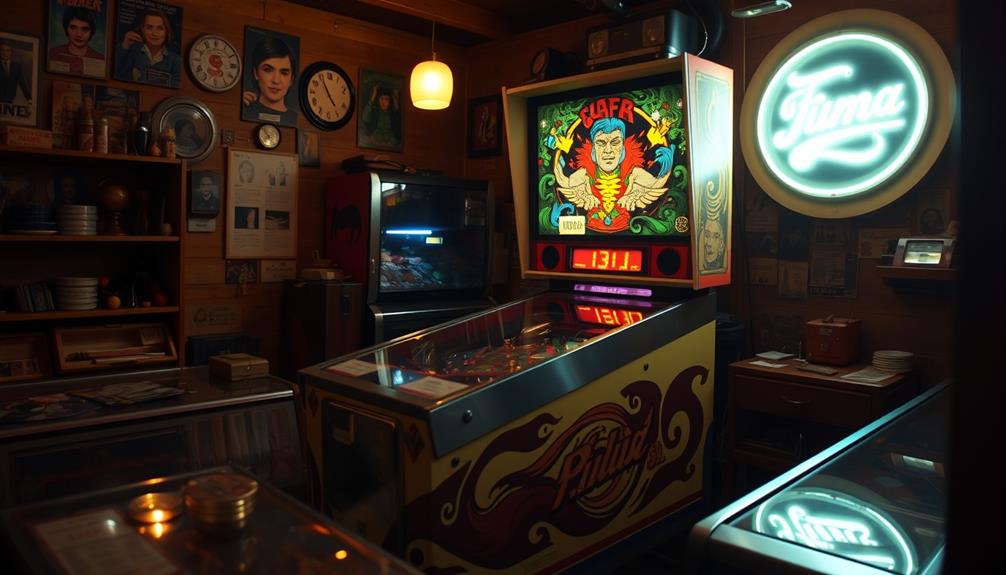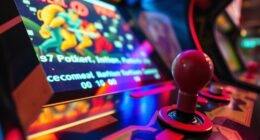Pinball’s prohibition originated from its early associations with gambling and societal fears. In the 1930s and 1940s, many saw pinball as a precursor to juvenile delinquency and crime, prompting cities to impose bans. Civic leaders spearheaded campaigns against it, arguing that it posed a threat to community values. Organized crime also took advantage of pinball, further tarnishing its reputation. While significant court rulings reclassified it as a skill-based game by the 1970s, remnants of its negative past persisted. Despite evolving perceptions over time, acknowledging this history is crucial to understanding pinball’s intricate journey towards acceptance in modern times.
Key Takeaways
- Pinball machines were banned in the 1930s due to their association with gambling and chance-based outcomes before the introduction of flippers.
- Civic leaders linked pinball to youth delinquency and moral decay, prompting public campaigns against its legality.
- Organized crime exploited pinball operations for money laundering, further tarnishing its image and leading to legal prohibitions.
- Early legal rulings classified pinball as a gambling device, reinforcing its illegal status in various cities.
- The societal perception of pinball as a threat to community values contributed to its long-standing bans until legal challenges in the 1970s.
Historical Context of Pinball
Pinball's history is steeped in controversy, particularly during the 1930s when many U.S. cities banned the machines. These bans arose from the widespread belief that early pinball machines were fundamentally gambling devices. Without flippers, players couldn't influence the outcome, making them more like games of chance. This perception led to numerous legal prohibitions, as local governments sought to curb illegal activities associated with gambling.
The legal landscape surrounding games of skill and chance can be quite complex, much like the building codes and zoning laws that vary for tiny houses.
In New York City, Mayor Fiorello La Guardia spearheaded an anti-pinball campaign in 1942, arguing that the ban was a moral necessity, especially amid concerns about juvenile delinquency during wartime. The connection between pinball and organized crime further fueled the public outcry, as machines were often linked to illicit operations in cities like Chicago.
As a result, many pinball machines were confiscated, reinforcing the stigma against them.
It wasn't until the California Supreme Court declared pinball a game of skill in 1974 that perceptions began to shift. This legal milestone marked the beginning of a gradual repeal of bans across various states, paving the way for pinball's resurgence as a beloved pastime rather than a symbol of illegal activity.
Early Legal Bans

Many people might be surprised to learn that early legal bans on pinball were rooted in the perception of the machines as tools for gambling rather than innocent games. In the 1930s, pinball machines became synonymous with illegal gambling. New York City Mayor Fiorello LaGuardia spearheaded the anti-pinball campaign, enacting a citywide ban in 1942. His administration confiscated over 2,000 machines, believing they exploited citizens financially and morally.
The media added fuel to the fire by sensationalizing pinball's ties to juvenile delinquency. Civic leaders rallied against the machines, fearing they corrupted youth and facilitated organized crime. Cities like Los Angeles and Milwaukee followed suit, enacting similar bans to combat these perceived threats.
Here's a quick look at the early legal bans:
| Year | City | Key Figure |
|---|---|---|
| 1930s | Various U.S. | — |
| 1942 | New York City | Mayor Fiorello LaGuardia |
| 1940s | Chicago | — |
| 1940s | Los Angeles | — |
| 1940s | Milwaukee | — |
These early bans laid the groundwork for pinball's long-standing illegal status in many areas.
Public Opposition and Morality

In the 1940s, you'd find pinball machines at the center of a moral panic, with many fearing their ties to gambling and youth delinquency.
This reaction can be likened to the public's misunderstanding of mental health issues, such as BPD dynamics in relationships, where fear and stigma often cloud judgment.
Public campaigns fueled by sensational media painted pinball as a threat to community values, pushing for its ban.
As concerned citizens rallied against what they saw as a corrupting influence, the game faced mounting opposition that ultimately shaped its legal status.
Gambling Associations Concern
Throughout the 1940s, a significant moral panic surrounded pinball due to its perceived connections to gambling. Many viewed pinball as a moral menace, prompting cities like New York to impose strict bans. The fear was palpable, as civic leaders and media painted pinball as a tool for exploitation, particularly among vulnerable youth.
This panic can be likened to the ways that trust issues in relationships can erode confidence and lead to harmful assumptions, as seen in trust issues with boyfriends.
You might find it shocking that:
- Law enforcement linked pinball machines to organized crime, suggesting a network of mob-controlled operations.
- Mayor Fiorello LaGuardia labeled pinball a gambling racket, further fueling public disdain.
- Sensational media reports exaggerated pinball's role in juvenile delinquency, creating a climate of fear and outrage.
These factors intensified the public outcry against pinball, framing the game as a conduit for gambling that preyed on the innocent.
The narrative around pinball was so powerful that it became synonymous with the very real concerns of exploitation and the dangers of organized crime. The resulting stigma led to widespread prohibition, shaping the perception of pinball for generations to come.
Even today, the echoes of that moral panic linger, often overshadowing the game's cultural significance.
Youth Delinquency Fears
The fears surrounding pinball extended beyond concerns about organized crime; they also tapped into deeper anxieties about youth behavior. Many viewed these machines as a corrupting influence, believing they led young people toward gambling and delinquency. Critics, including law enforcement and civic leaders, argued that pinball exploited vulnerable children, pushing them toward illegal activities.
| Concern | Description |
|---|---|
| Youth Delinquency | Pinball was seen as a gateway to delinquent behavior. |
| Gambling Influence | Critics claimed it encouraged gambling habits. |
| Societal Impact | Mayor Fiorello LaGuardia framed it as a threat to society. |
In the 1940s, sensationalist media fanned the flames of these fears, portraying pinball as a major factor in youth delinquency. This led to legislative actions, including the 1942 New York City ban, where machines were confiscated and destroyed. LaGuardia's anti-pinball campaign positioned these devices as mob-controlled gambling tools, threatening the moral fabric of society, particularly for youth. The combination of public outcry and moral panic solidified the perception that pinball was a dangerous influence on the younger generation.
Moral Panic Campaigns
Moral panic campaigns against pinball machines erupted in the 1940s as fears about youth delinquency and gambling grew. Pinball wasn't just a game; it was seen as a gateway to crime and immorality. This period was marked by a broader societal concern for existential themes regarding youth behavior and societal values.
Mayor Fiorello LaGuardia led the anti-pinball movement, declaring these gambling devices a threat to society. Public sentiment turned sharply against pinball, fueled by sensational media reports.
You might be shocked to learn that:
- Many pinball machines were confiscated and destroyed in public spectacles.
- Authorities portrayed players as reckless youths, spiraling into delinquency.
- The ban was framed as a wartime necessity, diverting resources to more "important" causes.
These campaigns reinforced the negative image of pinball, linking it to mob influences and social disorder. The raids and destruction of confiscated machines turned a game into a symbol of moral decay.
The anti-pinball movement thrived on this moral panic, using fear to justify extreme measures against something that, at its core, was just a source of entertainment. In this climate of suspicion, pinball was demonized, forever altering its place in American culture.
Pinball's Gambling Associations

Pinball's history is deeply intertwined with gambling associations that shaped public perception and legal status. In the 1930s and 1940s, cities deemed pinball machines illegal gambling devices due to their coin-operated nature. Without flippers, early pinball machines emphasized chance over skill, reinforcing the idea that it was a game of luck susceptible to gambling. This association made it easier for organized crime figures to exploit pinball operations for money laundering and other illegal activities, further tarnishing the game's reputation.
Additionally, the lack of regulation around these machines contributed to the perception of pinball as a risky investment, similar to diversification strategy discussions in finance, where spreading risk is essential.
Media portrayals linked pinball to juvenile delinquency, stirring public sentiment against it and prompting political action. The narrative that pinball encouraged gambling and exploited vulnerable citizens added fuel to the fire, leading to widespread bans across the country.
However, key legal rulings, like the California Supreme Court's 1974 decision declaring pinball a game of skill, challenged these gambling associations. This ruling was pivotal in changing perceptions and dismantling the illegal status of pinball. As a result, pinball slowly regained its footing, but the shadows of its gambling associations still linger, shaping discussions around its legality today.
Cultural Stigmatization

Throughout the 1940s and 1950s, the sight of brightly lit pinball machines in arcades sparked a wave of concern among parents and community leaders. They saw these machines as a gateway to juvenile delinquency, fueling fears that kids would be lured into a life of crime.
The media sensationalized pinball as a gambling vice, amplifying the cultural stigmatization surrounding it. This perception echoed the challenges faced in today's digital world, where distractions can hinder creativity and the nurturing of imaginative mindsets, similar to how pinball was viewed as a distraction from societal values igniting creativity in a digital world.
This public perception painted pinball as a moral threat, linked to organized crime and illegal gambling. Authorities and civic groups rallied against it, insisting that it threatened the finances and well-being of vulnerable citizens. You could feel the anxiety in the air; it was palpable.
Here are three reasons why pinball was viewed with such disdain:
- Youth Corruption: It was believed to lead children down a path of delinquency.
- Gambling Associations: The lack of flippers made pinball seem like pure chance, reinforcing its gambling ties.
- Moral Panic: Community leaders framed it as a threat to societal values.
This cultural stigmatization persisted, overshadowing the game with a legacy of suspicion and fear that lasted for decades.
Key Legal Milestones
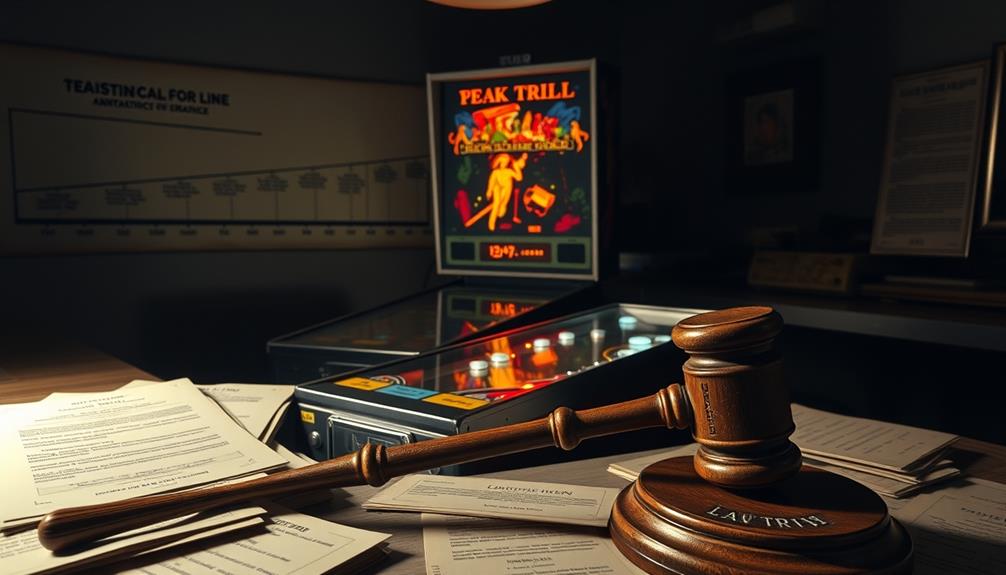
You might be surprised to learn how pinball's journey through legal battles shaped its status today.
Starting with outright bans in the 1930s and 1940s, key court rulings eventually shifted the perception of the game from gambling to skill-based entertainment.
Alongside these legal changes, the evolving landscape of gaming regulations has influenced how games like pinball are classified, often paralleling discussions around avoiding scams in investment.
These milestones not only changed the law but also reflected growing acceptance of pinball in society.
Historical Legal Bans
The history of pinball in the United States is marked by a series of legal battles that shaped its acceptance as a legitimate form of entertainment. Many cities outlawed pinball games during the 1930s due to their perceived ties to gambling and organized crime, similar to the challenges faced by other recreational activities like cold medications that have faced scrutiny over safety concerns.
New York City Mayor Fiorello LaGuardia led a ban on pinball in 1942, claiming it was a moral issue and a misuse of wartime resources.
This wave of prohibition brought significant challenges, including:
- Thousands of pinball machines confiscated, crushing the dreams of many enthusiasts.
- The association of pinball with criminal activity tarnishing its reputation.
- The struggle for recognition of pinball as a game of skill and not chance.
However, a turning point came in 1974 when the California Supreme Court ruled that pinball was indeed a game of skill.
This pivotal moment inspired a change in public perception. By the late 1970s, cities like Chicago and Los Angeles began lifting their bans, paving the way for pinball's resurgence and acceptance as a beloved form of entertainment.
Landmark Court Rulings
As pinball began its journey toward legitimacy in the late 20th century, several landmark court rulings played pivotal roles in reshaping its legal status. In 1974, the California Supreme Court ruled that pinball was a game of skill rather than chance, which led to the legalization of the game in Los Angeles and challenged its prior classification as illegal gambling. This ruling was significant for the pinball industry, paving the way for similar changes in other American cities.
Understanding the legal process of divorce proceedings can provide insight into how legal interpretations evolve over time.
In 1976, Roger Sharpe's demonstration in New York City highlighted the skill involved in pinball, prompting the city council to overturn its ban on pinball machines. Following this, in 1977, Chicago recognized the game's skill-based nature, lifting its ban and acknowledging the potential tax revenue from legalizing pinball.
However, the impact of earlier legal decisions lingered; as late as the 2000s, cities like Nashville and Oakland still maintained bans on pinball, reflecting outdated perceptions of gambling associated with the game. These landmark court rulings were vital in the gradual shift toward pinball's acceptance and legalization across the country.
The Role of Organized Crime

During the 1940s, pinball machines became entangled with organized crime, leading to a significant shift in public perception. Mobsters exploited these machines as fronts for illegal gambling and money laundering, transforming a simple game into a tool for corruption. Figures like Big Jim Elkins showed how deeply racketeering infiltrated the industry, with the Teamsters Union further entwining themselves in the operation of pinball machines.
This dark association with criminal activities mirrored other vulnerabilities seen in today's digital landscape, where cybersecurity challenges continue to pose risks for innocent users.
The connection between pinball and crime stirred public concern, prompting law enforcement to crack down. Here are three unsettling realities that emerged during this era:
- Gambling operations masked as innocent entertainment led to widespread addiction and financial ruin.
- Corruption within local law enforcement created an environment where crime thrived, undermining trust in authorities.
- Public morality was viewed as at risk, with officials arguing that pinball machines represented a vice that needed eradication.
These developments solidified the perception of pinball as a menace, paving the way for legislative efforts to ban it entirely. The intertwining of pinball with organized crime marked a dark chapter in its history, illustrating the consequences of corruption and illicit activities.
Shifts in Public Perception

By the mid-20th century, pinball's reputation had taken a dramatic turn, shifting from a mere pastime to a perceived threat to societal values.
In the 1940s, pinball machines became increasingly linked to gambling and juvenile delinquency, sparking widespread public concern. Moral panic swept through communities, fueled by civic leaders and media framing pinball as a corrupting influence on children. Influential figures like New York City Mayor Fiorello La Guardia amplified these fears, portraying pinball as a gambling racket exploited by organized crime.
However, the narrative began to shift in the 1970s. Legal challenges, including a landmark California Supreme Court ruling, defined pinball as a game of skill rather than chance, challenging the gambling stigma.
This redefinition altered public perception, leading to growing acceptance and eventual legalization of pinball in many areas.
Resurgence of Pinball
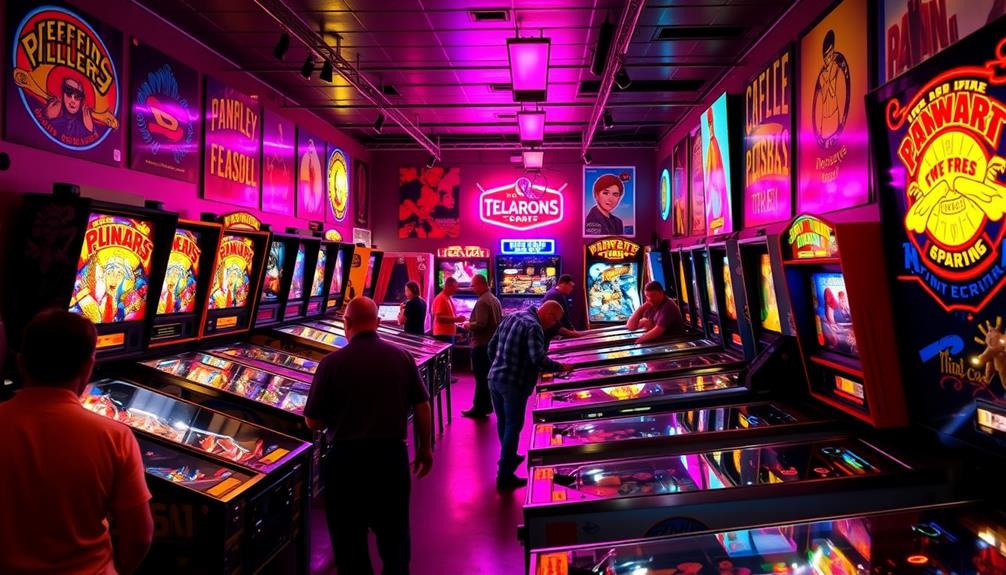
The resurgence of pinball has transformed it from a once-vilified pastime into a vibrant cultural phenomenon. After bans were lifted in cities like New York City in 1976, interest in pinball skyrocketed.
Today, you can find a thriving community engaged in tournaments and celebrating this iconic game.
Here are three reasons why pinball's resurgence is so thrilling:
- Tournaments: With over 1,800 annual events organized by the International Flipper Pinball Association, competitive play has never been more accessible.
- Technology: Modern machines boast LED displays and interactive features, attracting both nostalgic players and newcomers enthusiastic for a unique experience.
- Accessibility: The market for used pinball machines has expanded, with many options available for under $5,000, making it easier for collectors and casual players to join in the fun.
Pinball isn't just a game; it's a celebration of history and community.
Retro gaming venues and museums now spotlight pinball's rich legacy, drawing enthusiasts together and ensuring that this once-banned pastime continues to thrive.
Current Legal Status

Pinball's legal status has evolved greatly over the decades, shifting from widespread bans to a more accepted pastime. Historically, many U.S. cities deemed pinball illegal due to its ties with gambling. However, pivotal court rulings changed the landscape, bringing pinball into the legal fold.
| Year | City | Event |
|---|---|---|
| 1974 | Los Angeles | California Supreme Court legalized pinball |
| 1976 | New York | Ban lifted after Roger Sharpe's demo |
| 2004 | Nashville | Ban ended, joining other major cities |
| N/A | Ocean City, NJ | Specific restrictions still apply |
| N/A | Nationwide | Rise in pinball tournaments reported |
Today, pinball thrives in many urban centers, reflecting a broader acceptance of the game. While some cities maintain specific regulations, most places recognize pinball as a skill-based activity rather than gambling. Thanks to landmark decisions by the Supreme Court and advocacy from players, pinball's legal status has shifted greatly. You can now enjoy this classic game without the shadow of illegality hanging over it.
Frequently Asked Questions
Where Is Pinball Still Illegal?
Pinball's still illegal in places like Grove City, Ohio, and certain parts of New Jersey, where local laws restrict its operation. You might also find restrictions in cities with historical bans and gambling concerns. When pinball was illegal, it was often seen as a form of gambling, due to the potential for players to win free games or replays. However, with the rise of video gaming and changing attitudes towards the game, many areas have lifted their bans. Despite this, there are still pockets of resistance to pinball, where old laws are still in place.
Why Was Pinball Illegal in California?
You might think it's just a game, but pinball was deemed illegal in California because authorities believed it led to gambling, exploited vulnerable citizens, and contributed to crime, pushing for strict bans and moral outrage. Many people were outraged by this decision, arguing that pinball was simply a harmless form of entertainment. However, despite the controversy, pinball remained illegal in California until the mid-1970s. Even to this day, there are still a few locations where pinball is illegal due to outdated laws and regulations.
Why Was There a 35 Year Ban on Pinball?
You'll find the 35-year ban on pinball stemmed from moral concerns and its association with gambling. Lawmakers viewed it as a game of chance, prompting widespread legal prohibitions and intense crackdowns on machines throughout the U.S.
Why Were Pinball Machines Illegal in New York City?
Pinball machines were considered illegal in New York City due to concerns over gambling and organized crime influences. You'd find public sentiment against them, viewing pinball as a harmful activity for youth and vulnerable citizens.
Conclusion
Pinball's journey from illegal pastime to celebrated game reflects society's shifting values, much like a pinball bouncing between obstacles. Once seen as a threat, it's now embraced for its nostalgia and skill. As attitudes evolve, the barriers that once confined pinball have fallen, allowing it to thrive in arcades and bars. So, the next time you hear that familiar clink of a ball, remember how far this beloved game has come—and how it's finally found its rightful place.



